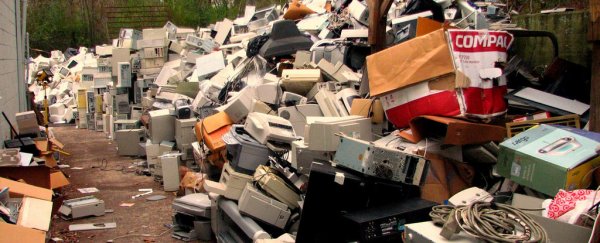Scientists have come up with a new solution for the mounting piles of e-waste that are rapidly building up on the planet, which are estimated to reach 50 million metric tonnes of discarded electronics worldwide next year.
According to a new study, we can simplify e-waste recycling by pulverising dumped electronics into nanodust – which researchers say could be a more efficient and environmentally friendly way of breaking down unwanted appliances and technology into ultra-fine particles that can then be repurposed.
Using a cryo-mill – a grinder that makes use of a freezing chamber to prevent heat-sensitive materials from melting together as they're ground up – engineers were able to mill printed circuit boards into nanoparticles that don't contaminate one another.
Compared with dumping e-waste into landfill or recovering metals and alloys via incineration and chemical treatments, the team says cryo-milling could be a much more economical use of discarded electronics.
"In every case, the cycle is one way, and burning or using chemicals takes a lot of energy while still leaving waste," says materials engineer Chandra Sekhar Tiwary from Rice University in Texas and the Indian Institute of Science.
"We propose a system that breaks all of the components – metals, oxides and polymers – into homogenous powders and makes them easy to reuse."
The team took two circuit boards from a computer mouse and used a cryo-mill to grind them at extremely cold temperatures – about -119 degrees Celsius (-182 degrees Fahrenheit) – thanks to a steady stream of liquid nitrogen inside the cooling chamber.
The cryo-mill grinding chamber also contains argon gas and a small steel ball, which when agitated was able to pulverise the circuit boards into a powder made up of incredibly fine particles measuring between just 20 and 100 nanometres wide.
For context, a human hair is approximately 80,000 to 100,000 nanometres wide, so we're talking really, really tiny here.
After the cold grind, the particles were then placed in water to separate them.
"Then they can be reused," says Tiwary. "Nothing is wasted."
While pulverising the circuits of one computer mouse (weighing less than 3 grams) won't exactly solve our mountainous e-waste problems – estimated to exceed 1 billion tonnes of dumped electronics by 2030 – as a proof-of-concept, it could indicate a new path ahead for e-recycling.
The researchers used a small commercial cryo-mill in their study, but say the same kind of concept could be scaled up to industrial proportions to help fix our growing e-waste dilemma.
"We take advantage of the physics. When you heat things, they are more likely to combine," says Tiwary.
"But in low temperatures, they don't like to mix… They allow everything to separate really well."
The findings are reported in Materials Today.
